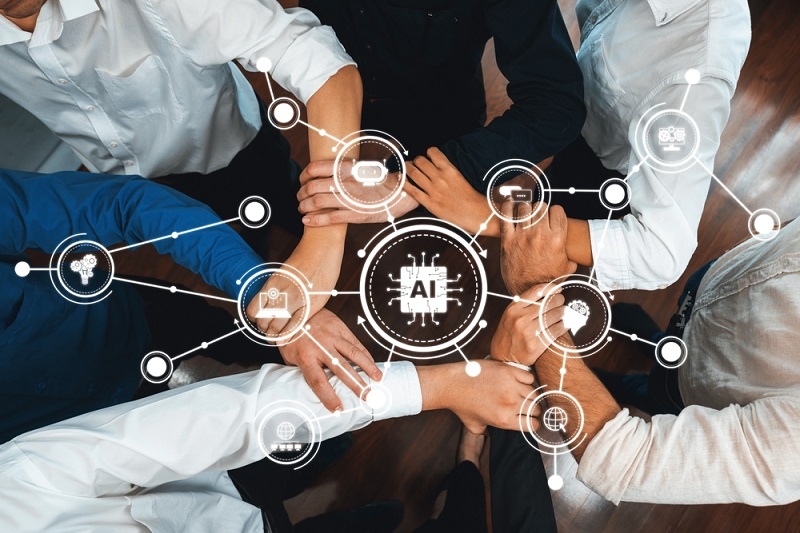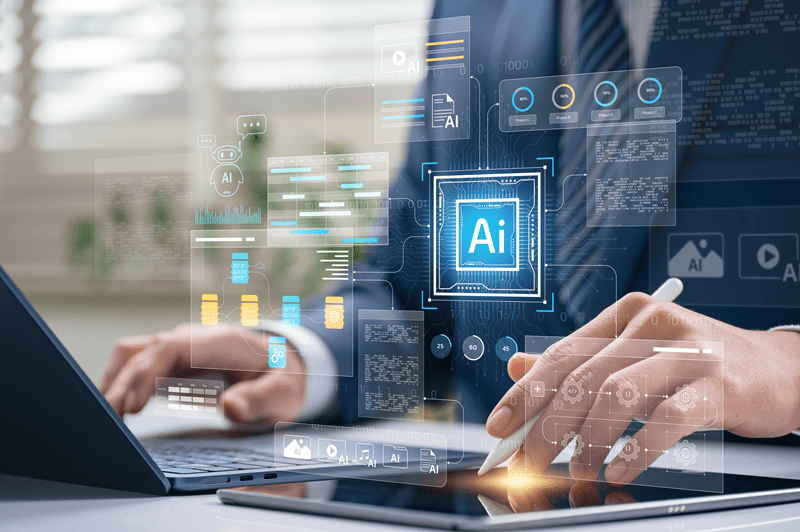How to Successfully Integrate AI in the Workplace

Nowadays, Artificial Intelligence (AI) is not a concept of the future anymore, but a realistic tool that transforms the way business is conducted in real life. AI has become a productivity revolution, whether it is automating repetitive tasks or processing large bodies of data in a matter of seconds. However, it is the strategic use of AI that is the actual success rather than the random application. This blog will discuss the influence of AI on productivity and the advantages of artificial intelligence in the workplace, practical uses, and how to successfully integrate AI into the work environment. You will realize by the conclusion that AI is not coming here to steal people's jobs, but rather to enable them.
AI in the Workplace: Transforming How We Work
In the workplace, AI is concerned with the adoption of technology in the day-to-day operations of a business so as to simplify the work, minimise human error, and maximise output.
Automating Repetitive Tasks With AI
Automation is one of the most significant benefits of AI in the workplace. AI can be easily used to perform repetitive and time-consuming tasks related to sorting emails, updating databases, and managing appointments. This will enable the employees to focus on work of high value that involves human understanding and emotional intelligence.
Enhancing Decision-Making Through Data Insights
The AI systems can process massive volumes of data within a few seconds, which cannot be done manually by a human being. These insights can help businesses make smarter and faster decisions. As an example, the sales teams may apply AI to understand customer behavior, whereas the HR department may apply it to determine the trends in employee engagement.
The Power Of Artificial Intelligence At Work
Artificial intelligence in the workplace not only simplifies work, but it also transforms the way employees perceive their work. Teams do not concentrate on the routine processes but start to look at the greater picture: innovativeness, creativity, and long-term strategy.
Let us consider the ways AI is transforming work in a number of ways.
Improving Communication And Collaboration
AI tools like virtual assistants and chatbots streamline communication by managing meeting schedules, taking notes, or even translating conversations between team members in real time. This creates smoother workflows, especially in remote or hybrid work environments.
Enhancing Employee Experience
The workplace can be personalized using AI. AI assists in making training programs more effective and in predicting burnout based on the analysis of data, which makes the environment more supportive. When productivity declines in someone, imagine a system that will automatically suggest taking a short break or changing tasks, that is, AI quietly working in the background to ensure the workplace is more human.
Boosting Creativity And Innovation
However, AI does not make people less creative, as many people think it does. AI also provides employees with more time to be creative by dealing with repetitive or analytical work. The AI-powered software can be used to brainstorm new ideas by design teams, do it more quickly by marketers, and have the engineers model product designs within record time.
AI For Business Success
Business AI is not a fad, but rather one of the requirements in the competitive world. All the key industries, healthcare included, are embracing AI tools in order to remain competitive.
Streamlining Operations
AI can be used to manage supply chains, predict demand, and improve logistics in businesses. This translates to fewer errors, fewer wastes, and fewer hiccups in operations. As an illustration, AI can notify the company about low stock or propose the most effective delivery path.
Increasing Customer Satisfaction
AI-assisted customer support systems and chatbots will be operational 24/7 and offer real-time support. They can respond to frequent inquiries, refund, and even recommend products, all retained in a human tone.
Reducing Costs And Wastage
AI systems have the ability to identify inefficiencies that may be missed by the human factor. Businesses can reduce costs by comparing spending, energy consumption, and resource distribution. In the long term, this will lead to an increase in profits and sustainable operations.
Workplace Automation: A Path To Smarter Work
One of the most effective pillars of AI-driven productivity is workplace automation. It is not only the machines performing the human labor, but also the combination of the two forces that makes a productive ecosystem.
Balancing Automation With Human Touch
One common fear about AI is job loss. However, the truth is that automation often enhances human roles instead of replacing them. It allows employees to take on more strategic, creative, and emotionally driven responsibilities.
Building A Culture Of Efficiency
When employees see AI as an ally rather than a threat, workplace culture improves dramatically. Automating tasks helps reduce burnout and stress, allowing workers to perform at their best. In return, businesses experience better retention, morale, and collaboration.
How To Implement AI In The Workplace

The implementation of AI in your company does not need to be a complex process. Strategy and not speed is the key to going one step in relation to the other.
That is how companies can successfully implement AI in the working process.
Step 1: Identify Pain Points
When you are deciding to implement any AI tool, identify the area in which your business is weakest. Is it speaking with customers, analysing data, or servicing? Being aware of these gaps will guide you to make the right selection of the tools to use, which will, in fact, resolve, but not cause more problems.
Step 2: Choose The Right Tools
The number of AI solutions in the present day is countless: automation platforms and predictive analytics tools. Choose those that match your goals and the size of the company. Begin simple, pilot, and grow as the employees get adjusted.
Step 3: Train Your Team
Training of employees is important in the process of introducing new technology. Human beings must learn about the functionality of AI and its uses, as well as its usefulness to them. Employees are comfortable with the use of AI and will readily embrace it.
Step 4: Monitor And Improve
The AI is not a one-time installation; it is a process of continuous learning. Periodically review the performance of your AI systems, take employee feedback, and improve. The larger the amount of data that AI obtains, the smarter and more efficient it becomes.
Step 5: Ensure Ethical Use
Finally, there is the ethical issue. Organizational actions should be open to the use of AI, particularly when dealing with employee or customer information. The trust is important to guarantee long-term success and the acceptance of AI tools.
Final Thoughts
It is not a race to the automation goal, as the steps to adopting AI in the workplace are about being smart and strategic in making choices that are aligned with the goals of your team. When organizations adopt AI to consider business, they create an opportunity to have a more productive and sustainable future. The appropriate AI tools have the potential to save time, decrease stress levels, and allow teams to concentrate on the most important aspects: innovation, teamwork, and human connection. The intelligent workplaces of the future are being designed in contemporary times, and AI is at the forefront.





